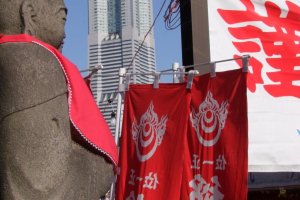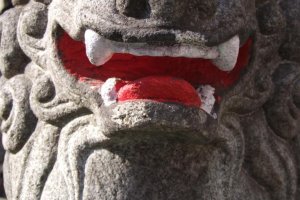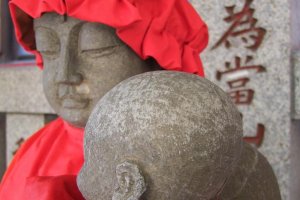If you are in the Sakuragicho/Minato Mirai area and would like to see something a little more ‘Japanese traditional’, then I recommend taking a stroll up the slope on the ‘other side’of the station to Narita-san Temple. It’ll take you about ten minutes on foot, and there are some steep stairs to manage, but once you are up there, you will be glad you came. It’s really quite interesting!
This is not a temple that is steeped in ancient history. It was set up around 150 years ago in 1870 as a satellite temple in Yokohama to the very famous Shinso-ji Temple in Narita, near Narita airport. Apparently, this temple is famous as a holy ground for the warding off of bad omens and other kinds of evil influences. One can’t help wonder when looking at the historical timeline, how much the arrival of Commodore Perry and his black ships in Yokohama Bay influenced its hasty creation.
The temple sits on a hill, overlooking the Minato Mirai area, and with a particularly good view of the Landmark Tower. 150 years ago, it would have had a perfect view of the entire bay and harbor.
The buildings and statues here are not ‘ancient’by any means, but they are quite old. This is a largish neighborhood-type temple where local business people and residence come to pray from time to time during the year. Indeed, you might be surprised at how completely surrounded by office buildings and apartment buildings the temple has become over the years. It is quite busy at the year-end and year beginning as people visit to celebrate and pray for the health and success of themselves and loved ones. They also come to buy the temple’s amulets and talismans, good luck charms that are said to be popular in the area.
Walk around the grounds and take note of the various building that house statues and alter. The temple has quite a few smaller outdoor statues as well, many of them dressed in red. Like many temples and shrines in Japan, the temple also sells food and drinks—depending on the season and whether or not a festival or ceremony is in progress.
I can’t say that this is the most beautiful temple in Japan, but it’s colorful and interesting, and will please those who want to get away from the hustle and bustle of the city for a short period of time.




































